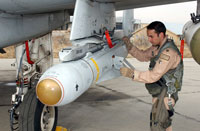|

CVR-7 ROCKET SYSTEM
This is an air-to-air and air-to-surface rocket system. Each rocket
pod, weighing 240 kg carries 19 rockets. The HE warhead is designed for
use against light armour, vehicles, small vessels and helicopters.
Deployed on the Harrier.

FREEFALL BOMBS
Conventional 1,000 lb (454 kg) bombs are still in service as are Mark 1
and Mark 2 bombs weighing 570 lb (260 kg). By adding the Hunting 118
retarding tail the weight of the latter is increased to 670 lb (304 kg).

PAVEWAY II
Paveway
II is the standard 1,000 lb (454 kg) general purpose bomb for use
against moderately well-protected targets.
Paveway II can be fitted
with a laser-guidance kit and the bomb can be used in the free-fall
or retarded mode.
Used on the Tornado
GR4, Harrier and Eurofighter Typhoon.
|
PAVEWAY
II Specifications
|
|
Length
|
3.7m
|
|
Weight
|
520kg
|
|
Guidance
|
Laser
|
Photo Copyright
Lockheed Martin

PAVEWAY III
AND TIALD (THERMAL IMAGING AND LASER DESIGNATION) POD
Paveway
III is a 2,000 lb (908 kg) laser-guided bomb (LGB) for use against
well-protected targets. The bomb is guided to its target by a TIALD
(Thermal Imaging and Laser Designation) pod that is carried on the
aircraft or by a ground-based observer using a target designator.
The
weapon can be carried on the Tornado GR4, Harrier, and Typhoon.
Unlike the Paveway
II, this weapon uses proportional guidance - the control canards on
the front of the bomb move only the exact amount necessary to guide
the weapon. This conserves energy, improves accuracy capability and
increases the range of the weapon, thus allowing delivery aircraft to
engage their targets with greater stand-off. When the weapon is
released, it flies a pre-programmed autopilot profile into the target
area, using the energy given to it by the releasing aircraft.
These
autopilot profiles are designated to provide the best attack
conditions for different types of target and also to use to maximum
effectiveness the increased stand-off capability of the weapon.
|
PAVEWAY
III
Specifications
|
|
Length
|
4.4m
|
|
Weight
|
1,130kg
|
|
Guidance
|
Laser
|

ENHANCED PAVEWAY
Shortcomings in
target acquisition during the 1999 Kosovo conflict resulted in a requirement for
the RAF to obtain a weapon to satisfy all-weather 24-hour tasking. The Enhanced
Paveway (EPW) family of weapons meets this requirement, and
the EPWII entered service in 2001 and the larger EPWIII entered service in late
2002.
Both EPWII and EPWIII are based on their laser-guided bomb variants, the
Paveway II and Paveway III respectively,
and utilise the same warheads and fin sections. However, the EPW weapons have a
modified guidance section and wiring to accommodate a Global Positioning System
Aided Inertial Navigation System (GAINS). EPW (also known as Paveway
IV) is carried by the Tornado GR4.
In Iraq, during Operation Telic in early 2003 the RAF used 360 x Enhanced
Paveway PGMs, and 255 Paveway II/III LGBs. Enhanced Paveway was described by the
RAF officers as “the weapon of choice”.
In November 2007 the Typhoon
dropped its first in-service bomb, the Paveway II and was declared operational
in the ground attack role.
|
ENHANCED
PAVEWAY Specifications
|
|
Length
(EPW2)
|
3.7m
|
|
Length
(EPW3)
|
4.4m
|
|
Weight
(EPW2)
|
545kg
|
|
Weight
(EPW3)
|
1,130kg
|
|
Guidance
|
GPS
|

PAVEWAY IV
In late 2003 the UK MoD selected the
Paveway IV PGM in preference to the Boeing Joint Direct Attack
Munition (JDAM). Paveway IV has the ability to engage targets in
all types of weather with laser guidance for high terminal
accuracy.
The Paveway IV kit, is equipped with a GPS/INS (Global Positioning
System/Inertial Navigation System) and a SAL (Semi-Active Laser)
terminal seeker. The total value of the contract is believed to be
in the region of £100 million.
Paveway IV is a joint development by the UK-based Raytheon
Systems Ltd (RSL) and Raytheon Missile Systems (RMS) in the US.
Paveway IV kits, fitted to 227 kg (500 lb) bombs, entered service
in 2008. During Operation Telic (Libya 2011) the UK’s precision
guided bombing capability was provided by 240 x Enhanced Paveway
II and 900 x Paveway IV.
Photo Copyright
Raytheon Systems

MAVERICK
|

|
|

|
The
Maverick missile, which is used by the Harrier GR7 as
an anti-armour weapon, entered RAF service in early
2001 and is one of the latest additions to the RAF
inventory.
The missile has a number of seeker heads available for
use in a variety of operational scenarios. The RAF
bought the Maverick with an Imaging Infrared (IIR)
seeker head, which allows the missile to be employed
both by day and by night and in poor atmospheric
conditions.
The Maverick missile will complement the Brimstone
missile that is entering RAF service with a
millimetric wave all-weather seeker head. The RAF
version of the Maverick is a fire-and-forget weapon,
which sends a picture from the IIR seeker head to the
Multi-Purpose Colour Display (MPCD) in the cockpit.
The pilot identifies the target, locks the missile
onto it and fires the missile once the target is in
range. The Maverick will then home onto the target
while the delivery aircraft carries out escape
manoeuvres, thus minimising its exposure to enemy air
defence systems.
|
MAVERICK
Specifications
|
| Length
|
2.6m
|
|
Diameter
|
0.31m
|
|
Span
|
0.71m
|
|
Weight
|
286kg
|
|
Range
|
27km
|
|
IR Guidance
|
Laser and
EO also available |
|